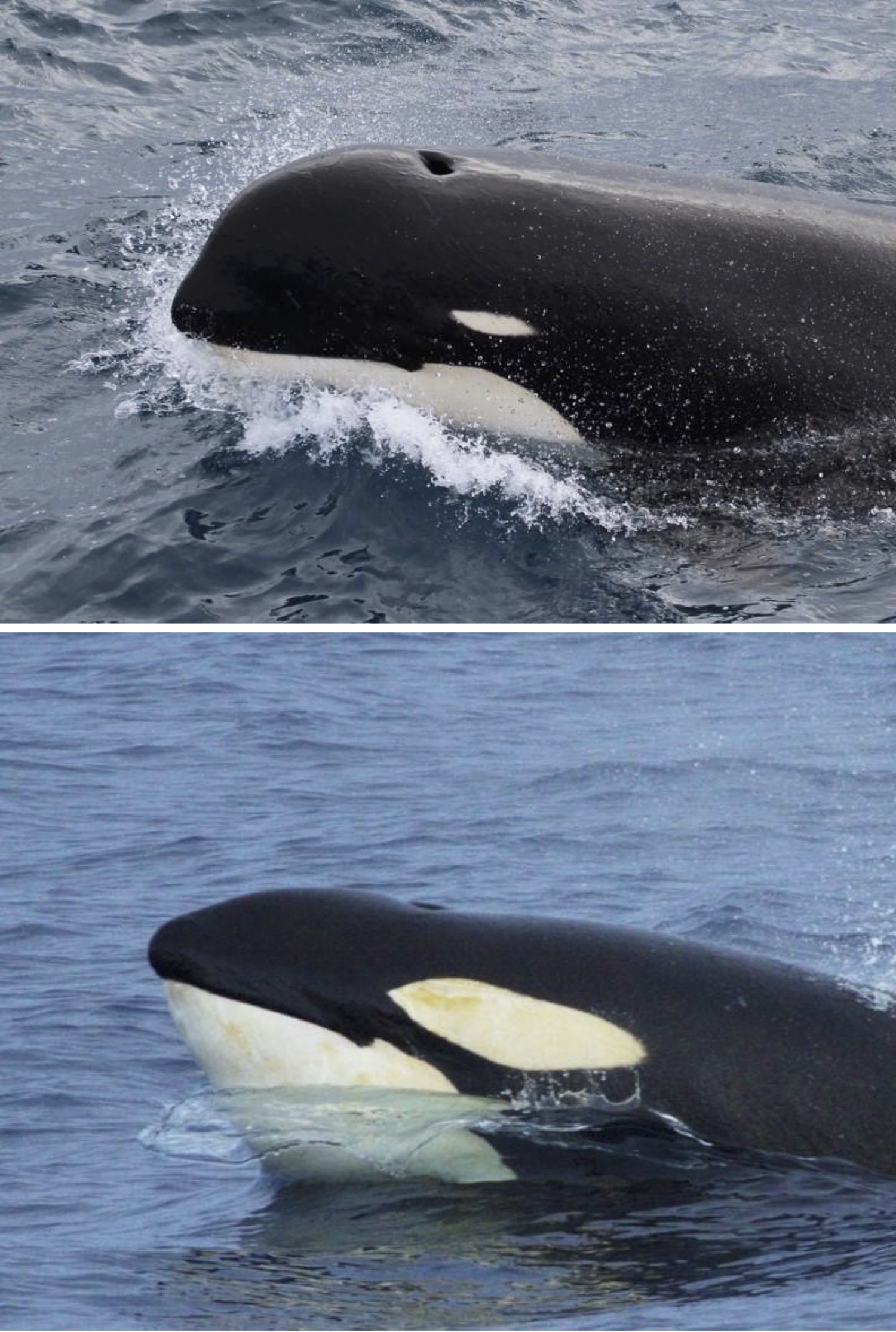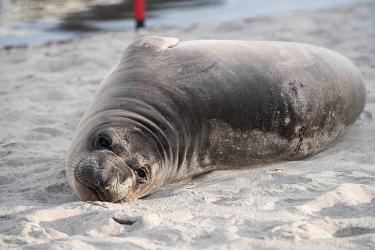A recently recognized and very different-looking type of killer whales native to the Southern Ocean has remained genetically isolated even though its range overlaps with other killer whale types. A new study analyzed genomes from the only known samples. They were taken from a skeleton from an animal stranded in Aotearoa, New Zealand in 1955, and from biopsies taken from live animals off Chile in 2019. Results published in the Journal of Heredity indicate that the “type D” killer whales have among the lowest genomic diversity and highest level of inbreeding of any mammalian species.
Killer whale “types”, often called ecotypes, are identified based on differences in appearance, behavior, habitat, and/or prey preferences. In the Southern Ocean, five different types have been recognized and given letter-names as they have been identified: types A, B1, B2, C and D.
In January 2019, an international team of researchers collected samples from living type-D killer whales for the first time. They were taken during a summer expedition off stormy Cape Horn, at the tip of South America. Type-D killer whales may represent a new species of killer whale, which could make it the largest undescribed species left on the planet.
The research found that type-D whales from Chile and New Zealand had almost identical genetic code, “which suggests inbreeding over many generations,” said Andrew Foote of the Norwegian Institute of Science and Technology, who is the lead author of the new research published today in the Journal of Heredity. “Any pair of type-D killer whales are genetically more similar than any pair of individuals from other known killer whale populations.”
The authors hypothesize that the low level of diversity may underlie the unique appearance of type-D killer whales, with their bulbous heads and tiny white eye patches. Their similar DNA makes it more likely that offspring will inherit the same DNA sequences responsible for otherwise recessive traits from both parents. In killer whale populations with more diverse DNA, offspring would inherit a greater mix of genes more likely to mask such traits. This may also be contributing to their reproductive isolation from other killer whales in the Southern Ocean.
Deciphering the DNA
Researchers Lisa Ballance and Robert Pitman (now with the Marine Mammal Institute, Oregon State University) led the international team on the 2019 expedition. They collected biopsy samples—tiny bits of skin collected from the animals with a crossbow dart. The genetic laboratories of the NOAA Southwest Fisheries Science Center are now helping decipher the genetic patterns from the samples to compare type-D whales with each other and with other killer whales around the world.
“Genetics helps us learn things about the species and their relationships that we might never have recognized otherwise,” said Phillip Morin, a research geneticist at the Southwest Fisheries Science Center. “It lets us look back into the history of the animals and understand how the species changed, and how that may affect its resilience and survival in a changing climate.”
One of the most widely distributed species in the world, killer whales span all oceans. They are currently recognized as one species, but include distinct populations, sometimes called “ecotypes.” Different ecotypes can have overlapping distributions but avoid interbreeding.
In 1955, a group of 17 killer whales stranded on the coast of Paraparaumu, New Zealand within the rohe (area) of Ngāti Toa Rangatira (the local Māori iwi i.e. “tribe”). Compared to other killer whales, they had more rounded heads, a narrower and more pointed dorsal fin, and a tiny white eyepatch. Killer whales with these unique features were not identified again until Pitman and colleagues analyzed more recent photographs of killer whales in the Southern Ocean. They found that this distinctive yet elusive form of killer whale occurred in a narrow circumpolar band of subantarctic waters known as the Roaring 40s and Furious 50s. They suggested the name “subantarctic killer whale” for this type).
On a tip that type-D killer whales were regularly stealing fish from fishermen’s lines off Chilean Cape Horn, the international team launched an expedition in 2019. They collected photos, videos, and the first biopsy samples from Type-D killer whales as they swam around the researchers’ boat, apparently looking for fish to steal.
Surviving a Bottleneck
When scientists compared DNA extracted from the biopsy samples from the Chilean whales to DNA obtained from museum specimens of the whales that stranded in New Zealand in 1955, they found the genetic patterns were almost identical. That indicates that type-D whales long ago went through a “genetic bottleneck,” perhaps driven by environmental change in the Southern Ocean, that reduced the population and left the remaining whales genetically similar.
The lack of genetic variation found in the genomes of the type-D whales implies they have since remained isolated for hundreds of generations, reproducing only with other type-D whales even though they likely encounter other types of killer whales that overlap their range. The result is that they have very similar DNA sequences, reflecting greater inbreeding than even highly endangered species such as mountain gorillas.
Inbreeding does not necessarily doom the species, however. Over the long term, smaller populations can persist despite lower genetic diversity. At the same time that generations of inbreeding may have exposed the unique traits we see in type-D killer whales, harmful recessive mutations that could lead to inbreeding depression will have been expressed and purged over time by natural selection.
“If there are few stressors, little competition and sufficient resources, then these small, isolated populations can persist,” Foote said. “If we added stressors that reduced survival and breeding success of these populations, that might tip the balance against these small but long-term persistent populations.”
That is the case with vaquitas, the smallest and most endangered marine mammal, with a small population shrinking as the few remaining vaquitas are killed in illegal gill nets in the Gulf of California. Recent genetic studies found that vaquitas were long a small and stable population until the illegal gillnets introduced a new threat that has quickly pushed them to the edge of extinction.
The scientists learned as they were preparing their research for publication that for the first time since the New Zealand strandings in 1955, another type-D whale has stranded, this time in Chile. That could further add to the genetic picture of the whales.
“The biopsy samples opened a window on these whales that seem to have found a place for themselves in the Southern Ocean where they have long survived,” Morin said. “This is an example of where a species shows signs of historical inbreeding but is not necessarily suffering from that. Additional samples and genomic studies will allow us to understand the timing and degree of isolation and adaptation of these elusive killer whales, and whether they are a different species.”



